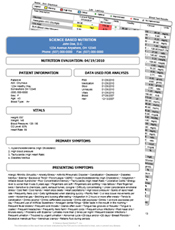The Cholesterol Theory:
THE MEETING OF SCIENCE AND POLITICAL INFLUENCE
For the better part of the last 50 years or more, we have been told to fear cholesterol and saturated fat as the cause of heart disease.1 Cholesterol is not the enemy and this newsletter will help to prove that fact. The vast majority of the information regarding cholesterol (as public enemy #1) has been the result of political persuasiveness rather than solid scientific evidence.
“Cholesterol is the most decorated molecule in history, having contributed to 13 Nobel prizes.” It is generally accepted that Dr. Nikolai Anichkov, the Russian physiologist, was the first to induce atherosclerosis by feeding rabbits a diet laden with cholesterol. He is therefore credited with originating the cholesterol hypothesis. It is quite clear that the focus of preventative cardiology for the last half century has been lifestyle modification and cholesterol reduction.2 The research study above, ignores the fact that rabbits are herbivores and would never eat a diet high in cholesterol in their natural environment.
In the 1950’s a physiologist from the University of Minnesota, Ancel Keys, became the Father of the Modern Cholesterol Hypothesis. To support his theory he cited the Seven Countries Study which is still considered one of the most rigorous epidemiological studies ever done.3
The aforementioned study focused on seven countries that had a high intake of saturated fat and also a high incidence of heart disease. He completely ignored the 15 other countries that did not support his theory. There were countries that have a low level of intake of saturated fat and yet high levels of heart disease. There were also countries that had high levels of saturated fat and relatively low heart disease.1
According to Dr. Peter Attia, the president and director of the Nutrition Science Initiative; an independent obesity research center. He stated the Keys study, “was highly flawed; it was not on the level of epidemiology work today.”4 Malcolm Kendrick, who authored The Great Cholesterol Con, was able to prove the exact opposite hypothesis using the same data set.5
The American Heart Association in 1957 was not convinced of the validity of the cholesterol hypothesis and called for controlled studies to be carried out. The studies were started but terminated early citing “lack of funding”. By 1961 Keys had made his way onto the Board of the American Heart Association and several skeptics had vacated their Board positions. With no change in evidence the Board abruptly flipped from their previous position in opposition to the Cholesterol Hypothesis, to one that fully supported and embraced this theory.
While Keys continued to gain notoriety by actively promoting the Cholesterol Hypothesis, the Sugar Research Foundation was secretly funding research by Harvard nutritionists; Frederick Stare and Mark Hegsted; both PhD’s. They were paid the equivalent of $50,000 in today’s dollars to try to influence and minimize the effects of sugar’s role in heart disease.6 The findings from their research were published without acknowledging the financial conflict of interest in the NEJM (New England Journal of Medicine) in August 1967.7
“Early warning signals of coronary heart disease risk and the connection with sugar (sucrose) emerged in the 1950’s. We examined Sugar Research Foundation (SRF) internal documents, historical reports, and statements relevant to early debates about the dietary causes of CHD and assembled findings chronologically into a narrative case study. The SRF sponsored its first CHD research project in 1965, a literature review published in The New England Journal of Medicine, which singled out fat and cholesterol as the dietary causes of CHD and downplayed evidence that sucrose consumption was also a risk factor.”8
Then the government got involved in the controversy. On January 14, 1977 the Senate Committee lead by George McGovern announced the release of “Dietary Goals for the United States.”9
- Increase carbohydrate consumption to account for 55 to 60% of energy/caloric intake
- Reduce overall fat consumption from approximately 40 to 30% energy intake
- Reduce saturated fat consumption to account for about 10% of the total energy intake; and balance that with poly-unsaturated and mono-unsaturated fats, which should account for 10% of energy intake
- Reduce cholesterol consumption to about 300mg/day
- Reduce sugar consumption by 40% to account for about 15% of total energy intake
- Reduce salt consumption by about 50-85% to approximately 3g/day
At this time it was still very controversial as to whether or not saturated fat was the cause of the disease. In fact numerous studies contradicted the cholesterol and fat hypothesis.10,11,12
When asked later for his thoughts Senator McGovern is quoted as saying, “I would only argue that senators don’t have the luxury that a research scientist does awaiting until every last shred of evidence is in.”13 McGovern wasn’t the author of the guidelines, instead this task fell on the shoulders of Nick Mottern, a former labor reporter, with no background in nutrition. Mottern sought counsel from Harvard nutritionist Mark Hegsted PhD. Dr. Hegsted was also known to be the co-author of the study commissioned by the Sugar Research Foundation previously mentioned in this article. His financial conflict was once again, not revealed to the committee.14
Perhaps the most significant development was the recognition of previously unpublished data from the Minnesota Coronary Experiment conducted from 1968-1973. The lead investigators of the MCE were Ancel Keys and Ivan Frantz. There data was kept from McGovern’s committee. Those findings were in direct conflict with the Cholesterol Hypothesis and would likely have had a dramatic impact on the guidelines.15
In summary, the Cholesterol Hypothesis has since its inception been highly controversial considering the data and political influence. Ancel Keys, who worked his way onto the board of the American Heart Association to further promote his own flawed theory. It became the official government policy based upon the work of the McGovern committee which was not aware of all the research findings at the time. The second conflict arose when the American Sugar Foundation hired Dr. Mark Hegsted. McGovern’s previous quote, “he did not have the luxury of waiting until all the information was in” rings true as further evidence of impropriety.
The final quote is from author Gary Taubes book, Good Calories Bad Calories, “as I emerge from this research, though, certain conclusions seem inescapable to me, based upon the existing knowledge: 1. dietary fat whether saturated or not, is not the cause of obesity, heart disease, or any other chronic disease of civilization.16
Meeting with and getting your health information from a qualified clinical nutritionist is paramount. At our practice we use a complement of diagnostic testing to put together natural health plans to address a wide variety of ill-health conditions. Getting you and your family tested properly may be the next most crucial decision you make. Let us know how we can help.
References:
- Seim, J.P. The Cholesterol Hypothesis. Nutritional Perspectives: Journal of the Council on Nutrition of the American Chiropractic Association. Vol. 40. No. 2.
Pg. 38-40.
- Seim, J.P. CVD, Statin drugs and heart failure nutritional alternatives. Nutritional Perspectives: Journal of the Council of Nutrition of the American Chiropractic Association. 28. No. 3. July 2005.
- Keys, A. K Ration Creator, Dies (washingtonpost.com) Nov. 23, 2004.
- Walsh, Brian. Don’t Blame Fat. Time Magazine cover story June 23, 2014.
- Kendrick, Malcolm. The Great Cholesterol Con; copyright 2007. Published by John Blake publishing ltd.
- O’Connor A. How the Sugar Industry Shifted Blame to Fat. New York Times September 12, 2016.
- McGrandy R., Hegsted, D and Stare, F. New England Journal of Medicine 1967, 277:242-247 Aug. 3, 1967.
- Kearns, CE, Schmidt LA, Glantz SA. Sugar Industry and Coronary Heart Disease Research: A Historical Analysis of Internal Industry Documents. JAMA Intern Med. 2016; 176 (11): 1680-1685
- US Dept. of Agriculture Nutrition and Your Health: Dietary Guidelines for Americans. Appendix G-5: History of the Dietary Guidelines for Americans.
https://health.gov/DIETARYGUIDELINES/dga2005/report/HTML/G5_History.htm
- The Oslo Diet-Heart Study. Paul Leren Circulation. 1970; 42: 935-942, originally published November 1, 1970. https://doi.org/10.1161/01.CIR.42.5.935
- The Multiple Risk Factor Intervention Trial (MRFIT). A national study of primary prevention of coronary heart disease. (1976) JAMA. 235(8):825-827.
- Mahmood SS, Levy D, Vasan RS, Wang TH. The Framingham Heart Study and the Epidemiology of Cardiovascular Diseases: A Historical Perspective. Lancet. 2014; 383(9921):999-1008.
- Senator George McGovern D South Dakota. YouTube “Saturated Fat and Cholesterol Lies” from FatHead (2008) 11:38 -11:45
- Time Magazine. September 12, 2016. How the Sugar Lobby Skewed Health Research. Alexandra Sifferlin. Sept 12, 2016.
- Re-evaluation of the traditional diet-heart hypothesis: analysis of revered data from Minnesota Coronary Experiment (1968-73). BMJ 2016; 353. Published 12 April 2016. Taubes, Gary (9-25-2007). Good Calories, Bad Calories. Knopf Doubleday Publishing Group. Kindle Edition.


